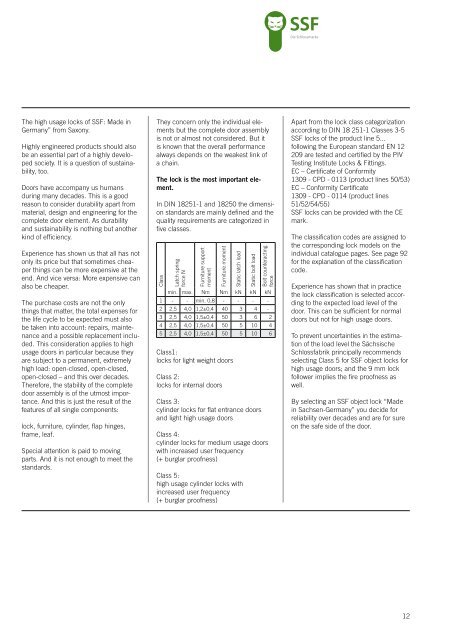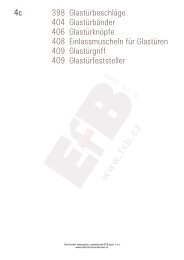Create successful ePaper yourself
Turn your PDF publications into a flip-book with our unique Google optimized e-Paper software.
<strong>The</strong> high usage locks of SSF: Made in<br />
Germany” from Saxony.<br />
Highly engineered products should also<br />
be an essential part of a highly developed<br />
society. It is a question of sustainability,<br />
too.<br />
Doors have accompany us humans<br />
during many decades. This is a good<br />
reason to consider durability apart from<br />
material, design and engineering for the<br />
complete door element. As durability<br />
and sustainability is nothing but another<br />
kind of efficiency.<br />
Experience has shown us that all has not<br />
only its price but that sometimes cheaper<br />
things can be more expensive at the<br />
end. And vice versa: More expensive can<br />
also be cheaper.<br />
<strong>The</strong> purchase costs are not the only<br />
things that matter, the total expenses for<br />
the life cycle to be expected must also<br />
be taken into account: repairs, maintenance<br />
and a possible replacement included.<br />
This consideration applies to high<br />
usage doors in particular because they<br />
are subject to a permanent, extremely<br />
high load: open-closed, open-closed,<br />
open-closed – and this over decades.<br />
<strong>The</strong>refore, the stability of the complete<br />
door assembly is of the utmost importance.<br />
And this is just the result of the<br />
features of all single components:<br />
lock, furniture, cylinder, flap hinges,<br />
frame, leaf.<br />
Special attention is paid to moving<br />
parts. And it is not enough to meet the<br />
standards.<br />
<strong>The</strong>y concern only the individual elements<br />
but the complete door assembly<br />
is not or almost not considered. But it<br />
is known that the overall performance<br />
always depends on the weakest link of<br />
a chain.<br />
<strong>The</strong> lock is the most important element.<br />
In DIN 18251-1 and 18250 the dimension<br />
standards are mainly defined and the<br />
quality requirements are categorized in<br />
five classes.<br />
Class<br />
Latch spring<br />
force N<br />
Furniture support<br />
moment<br />
Furniture moment<br />
Static latch load<br />
Static bolt load<br />
Bolt counteracting<br />
force<br />
min. max. Nm Nm kN kN kN<br />
1 - - min. 0,8 - - - -<br />
2 2,5 4,0 1,2±0,4 40 3 4 -<br />
3 2,5 4,0 1,5±0,4 50 3 6 2<br />
4 2,5 4,0 1,5±0,4 50 5 10 4<br />
5 2,5 4,0 1,5±0,4 50 5 10 6<br />
Class1:<br />
locks for light weight doors<br />
Class 2:<br />
locks for internal doors<br />
Class 3:<br />
cylinder locks for flat entrance doors<br />
and light high usage doors<br />
Class 4:<br />
cylinder locks for medium usage doors<br />
with increased user frequency<br />
(+ burglar proofness)<br />
Class 5:<br />
high usage cylinder locks with<br />
increased user frequency<br />
(+ burglar proofness)<br />
Apart from the lock class categorization<br />
according to DIN 18 251-1 Classes 3-5<br />
SSF locks of the product line 5...<br />
following the European standard EN 12<br />
209 are tested and certified by the PIV<br />
Testing Institute <strong>Lock</strong>s & Fittings.<br />
EC – Certificate of Conformity<br />
1309 - CPD - 0113 (product lines 50/53)<br />
EC – Conformity Certificate<br />
1309 - CPD - 0114 (product lines<br />
51/52/54/55)<br />
SSF locks can be provided with the CE<br />
mark.<br />
<strong>The</strong> classification codes are assigned to<br />
the corresponding lock models on the<br />
individual catalogue pages. See page 92<br />
for the explanation of the classification<br />
code.<br />
Experience has shown that in practice<br />
the lock classification is selected according<br />
to the expected load level of the<br />
door. This can be sufficient for normal<br />
doors but not for high usage doors.<br />
To prevent uncertainties in the estimation<br />
of the load level the Sächsische<br />
Schlossfabrik principally recommends<br />
selecting Class 5 for SSF object locks for<br />
high usage doors; and the 9 mm lock<br />
follower implies the fire proofness as<br />
well.<br />
By selecting an SSF object lock “Made<br />
in Sachsen-Germany” you decide for<br />
reliability over decades and are for sure<br />
on the safe side of the door.<br />
12






